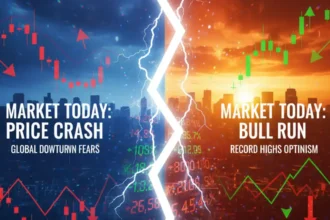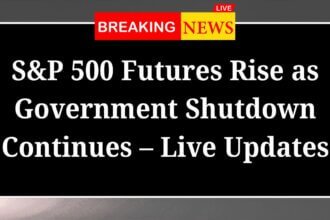S&P 500 and Nasdaq Maintain Historic Levels Amid Market Uncertainties
In a remarkable show of resilience, both the S&P 500 and Nasdaq have sustained their positions above key technical levels for an extended period, marking the longest stretch in over a decade. This trend has left analysts and investors pondering the implications for the broader market landscape as they navigate through ongoing economic challenges and geopolitical tensions. As of mid-October 2023, the S&P 500 index is firmly above the crucial 4,200 mark, while the Nasdaq Composite consistently holds above 13,000, reflecting a complex interplay of factors influencing the market.
Understanding the Current Market Landscape
These benchmarks are not merely arbitrary numbers; they represent vital psychological and technical barriers for traders and investors alike. The S&P 500’s current streak above the 4,200 threshold is the longest since 2011. According to data from MarketWatch, this period of stability showcases a significant level of market confidence despite potential headwinds, such as inflationary pressures and geopolitical uncertainties.
The recent performance of these indices has prompted many market watchers to evaluate what this might mean for the future of investment. The sustained levels indicate that a considerable portion of the investing community believes in the economic fundamentals supporting the market, even as external factors loom large.
Economic Indicators and Investor Sentiment
Investor sentiment plays a pivotal role in the performance of these indices. Recent economic indicators, including unemployment rates and consumer spending, have exhibited mixed signals. The U.S. Bureau of Labor Statistics reported a slight uptick in job growth, with non-farm payrolls increasing by 210,000 in September. Despite this positive berawangnews.com, the unemployment rate remains steady at 3.8%, leading to a nuanced outlook on economic stability.
“Investors are cautiously optimistic,” said Mark Zandi, chief economist at Moody’s Analytics. “While the job market shows resilience, inflation concerns continue to loom large, influencing spending patterns and investment strategies.” This sentiment is echoed by many in the financial community, who note that consumer confidence is critical for sustaining economic growth in the coming months.
Technical Analysis: What the Charts Reveal
Technical analysts are closely monitoring the moving averages of both indices. A sustained position above these levels could signal a bullish trend. The 50-day moving average for the S&P 500 stands at approximately 4,150, while the Nasdaq’s 50-day average hovers around 12,800. The fact that both indices are trading above these averages has encouraged some investors to adopt a more aggressive stance.
Additionally, the Relative Strength Index (RSI) for both indices indicates that they are not yet in overbought territory, suggesting there may still be room for growth. However, analysts caution that a sudden shift in market sentiment could quickly alter this landscape. The interplay of external factors, including economic indicators and geopolitical volatility, underscores the importance of vigilance in decision-making.
Geopolitical Factors at Play
Geopolitical tensions, including ongoing conflicts in Eastern Europe and trade disputes in Asia, pose risks that could disrupt market stability. Investors are particularly wary of how these issues might impact global supply chains and commodity prices, which have already experienced volatility this year. The ongoing conflict between Russia and Ukraine continues to affect energy prices and supply chains, creating ripples across various sectors.
“Market participants are keenly aware of the geopolitical landscape,” noted Sarah House, senior economist at Wells Fargo. “Any escalation could lead to heightened market volatility, particularly in sectors sensitive to trade.” The interconnectedness of global economies means that investors must keep an eye on international developments, as these can have immediate and profound effects on domestic markets.
The Role of Technology Stocks
Technology stocks, a significant driver of growth in the Nasdaq, have played a crucial role in propelling these indices above their critical levels. Companies like Apple, Microsoft, and Nvidia have posted strong quarterly earnings, reinforcing investor confidence. As of late September, the technology sector accounted for approximately 27% of the S&P 500’s total market capitalization, according to S&P Dow Jones Indices.
However, a slowdown in tech spending or regulatory challenges could dampen this growth. “While tech has been the backbone of this rally, any signs of weakening demand could shift the dynamics rapidly,” cautioned Tom Lee, co-founder of Fundstrat Global Advisors. This diversification of investment across sectors is crucial for mitigating risks associated with potential downturns in technology stocks.
Looking Ahead: What’s Next for Investors?
As we approach the end of the fourth quarter, investors are left to wonder how long these indices can maintain their positions above critical levels. Market analysts suggest that the forthcoming earnings season will provide crucial insights into corporate performance and consumer sentiment. Companies are expected to report their third-quarter earnings, which could either validate the current optimism or signal potential weaknesses.
Additionally, the Federal Reserve’s decisions regarding interest rates will also impact market trajectories. With inflation still a concern, any signs of a more hawkish stance by the Fed could lead to increased volatility. Investors are closely monitoring economic indicators and Fed communications for clues about future policy changes.
The Importance of Diversification
In the current market environment, diversification remains a key strategy for investors. With the potential for volatility stemming from both economic and geopolitical factors, spreading investments across various sectors can help mitigate risks. Financial advisors often recommend a balanced portfolio that includes equities, bonds, and alternative investments to safeguard against market fluctuations.
Frequently Asked Questions
What are the key technical levels for the S&P 500 and Nasdaq?
The S&P 500 is currently holding above the 4,200 mark, while the Nasdaq Composite is above 13,000. These levels are critical psychological barriers for investors.
Why is the current stretch above these levels significant?
This marks the longest duration both indices have held above these thresholds in over a decade, indicating strong market confidence amidst economic uncertainties.
What economic indicators are influencing investor sentiment?
Key indicators include job growth data, consumer spending trends, and inflation rates, all of which impact how investors perceive the stability of the market.
How do geopolitical issues affect the market?
Geopolitical tensions can lead to increased market volatility, particularly in sectors sensitive to trade and supply chain disruptions. Investors are closely monitoring these developments.








